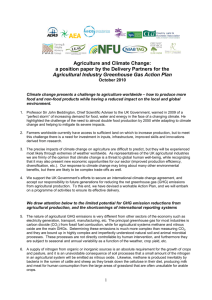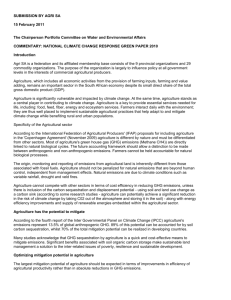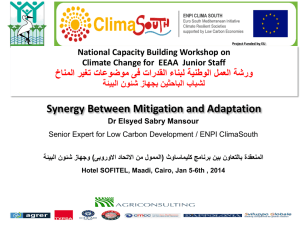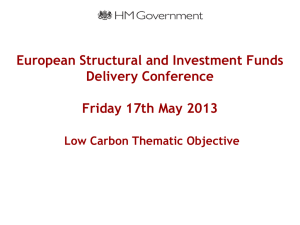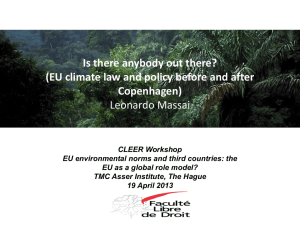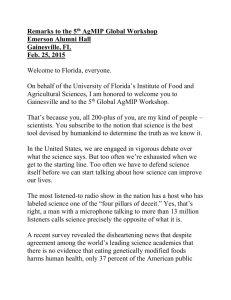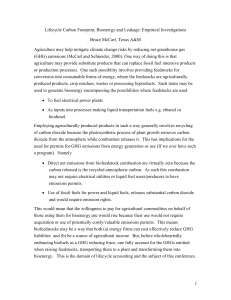SCNC_Research Group Summary
advertisement
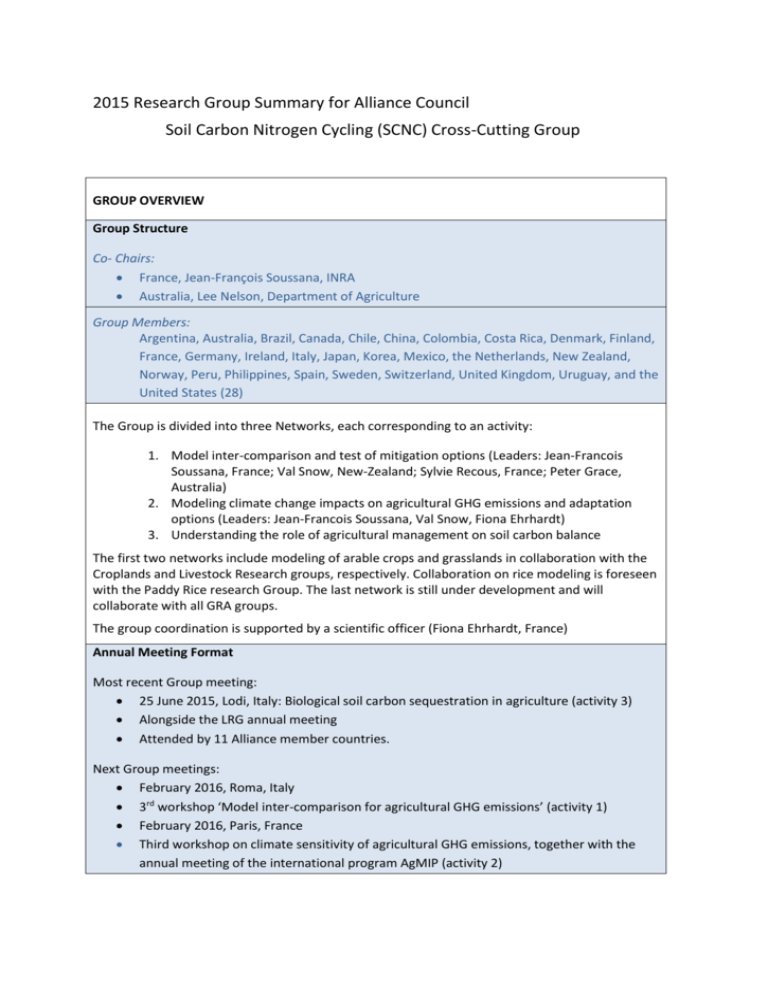
2015 Research Group Summary for Alliance Council Soil Carbon Nitrogen Cycling (SCNC) Cross-Cutting Group GROUP OVERVIEW Group Structure Co- Chairs: France, Jean-François Soussana, INRA Australia, Lee Nelson, Department of Agriculture Group Members: Argentina, Australia, Brazil, Canada, Chile, China, Colombia, Costa Rica, Denmark, Finland, France, Germany, Ireland, Italy, Japan, Korea, Mexico, the Netherlands, New Zealand, Norway, Peru, Philippines, Spain, Sweden, Switzerland, United Kingdom, Uruguay, and the United States (28) The Group is divided into three Networks, each corresponding to an activity: 1. Model inter-comparison and test of mitigation options (Leaders: Jean-Francois Soussana, France; Val Snow, New-Zealand; Sylvie Recous, France; Peter Grace, Australia) 2. Modeling climate change impacts on agricultural GHG emissions and adaptation options (Leaders: Jean-Francois Soussana, Val Snow, Fiona Ehrhardt) 3. Understanding the role of agricultural management on soil carbon balance The first two networks include modeling of arable crops and grasslands in collaboration with the Croplands and Livestock Research groups, respectively. Collaboration on rice modeling is foreseen with the Paddy Rice research Group. The last network is still under development and will collaborate with all GRA groups. The group coordination is supported by a scientific officer (Fiona Ehrhardt, France) Annual Meeting Format Most recent Group meeting: 25 June 2015, Lodi, Italy: Biological soil carbon sequestration in agriculture (activity 3) Alongside the LRG annual meeting Attended by 11 Alliance member countries. Next Group meetings: February 2016, Roma, Italy 3rd workshop ‘Model inter-comparison for agricultural GHG emissions’ (activity 1) February 2016, Paris, France Third workshop on climate sensitivity of agricultural GHG emissions, together with the annual meeting of the international program AgMIP (activity 2) WORKPLAN OVERVIEW Workplan activities and funding Activities: Activity 1. Model intercomparison and test of mitigation options To date, model inter-comparison and benchmarking has been performed in a fully blind test comprising five calibration steps with 28 models and 10 sites spanning four continents with temperate grasslands, wheat and maize. Multi-model medians are shown to be robust predictors of yields and GHG emissions. Manuscripts are being prepared for publication. Last activity 1 meeting held in Fort-Collins (USA), March 2015. Current status: Model intercomparison and benchmarking (step 4 in progress for temperate grasslands, wheat and maize in arable crop rotations). Tropical grasslands (planned for end of year). Test of mitigation options (starting next November). Further developments anticipated: soybean and paddy rice. Participation: Four countries lead an activity (France, New-Zealand, Australia, USA). Additional activities led by Australia, Canada and Brazil are in the planning stage. 12 member countries participate in activity 1 (Australia, Brazil, Canada, China, France, Germany, Italy, New Zealand, Spain, Switzerland, United Kingdom, and the United States), in addition with India. Other GRA countries are expected to join when modeling mitigation options. Funding is provided through: Collaborative projects funded by the international call on agricultural GHG involving Europe (FACCE JPI), New-Zealand and USA (i.e. CN-MIP, Model4Pastures, MaGGnet) and by FACCCE JPI (Macsur). French research funding provided by ADEME Australian research funding Activity 2. Modeling climate change impacts on agricultural GHG emissions and adaptation options (Joined activity with AgMIP). Climate sensitivity of agricultural production and associated GHG emissions is being assessed with temperate grasslands as a pilot. Sensitivity to temperature, precipitation, and atmospheric CO2 is assessed for site calibrated models based on the C3MP protocol developed for crop yields by AgMIP. Extension to tropical grasslands is planned by the end of the year. Extension to arable crop GHG emissions (i.e. wheat and maize) is foreseen for early 2016. Emulators of multi-models climate sensitivity are shown to provide robust projections across sites. First results suggest that the use of such emulators may provide a fast-track for gridded projections of agricultural emissions sensitivity to climate change scenarios. A first manuscript is prepared for publication. Last activity 2 meeting held in Gainesville (USA), March 2015. Two countries lead the pilot temperate grassland activity (France, New-Zealand). Additional activity for tropical grasslands led by Australia planned. 8 member countries participate in this activity (Australia, Belgium, Canada, France, Germany, New Zealand, United Kingdom, and the United States). Funding is provided through: French research funding provided by ADEME AgMIP program support for activity 2 meetings. Activity 3. Understanding the role of agricultural management on soil carbon balance This activity is a new development which has been discussed and agreed by member countries during the June 2015 Lodi meeting alongside the annual meeting of the LRG. It corresponds to an action plan proposed by the French government as part of the ‘Agenda of Solutions’ of COP21 (December 2015, Paris). The research activities will contribute to improve our understanding of the baseline of agricultural soil carbon stock changes at regional and country scales, to the assessment of biological soil carbon sequestration in agriculture and of corresponding good management practices in different systems and to the development of Monitoring, Reporting and Verification. These activities will be developed in close collaboration with the three research groups and with the I&M cross-cutting group. Collaboration with several international and national research programs is foreseen. Member countries will be invited to express their interest. Capability building activities and funding We see these activities as being part of the interactions between the cross-cutting group and the three research groups. 1. 2. 3. 4. Capacity building. To be organized with Research group networks. any fellowships /exchanges programmes. None yet. training workshops. To be organized with Research groups networks. online manuals and databases developed etc. To be organized with Research groups networks. DISCUSSION TOPICS Communication Communicating Group activities to members: 1. Meeting reports & Summaries are available online. 2. Newsletters. The cross-cutting group contributes to Newsletters from research groups (e.g. to the LRG newsletter). 3. Social media (none, but a joined database is being developed and shared through Dropbox. It will be made public after first publications) Communicating Group activities externally: 1. Meeting report summaries. Available online. 2. Research Group webpages and workplan. Available online. Joint activities with Partners workshop side events presentations posters etc. Identified and planned activities that promote mitigation and adaptation synergies The cross-cutting group activities deal both with mitigation (activity 1) and adaptation (activity 2), while soil carbon sequestration (activity 3) has a strong potential for synergy between mitigation and adaptation. Moreover, by studying climate sensitivity of agricultural GHG emissions (activity 2), the group has a strong contribution on the interactions between adaptation to climate change and mitigation. Next steps for the Group – The new Activity on biological soil carbon sequestration, an item proposed for the agenda of solutions during COP21-Paris

